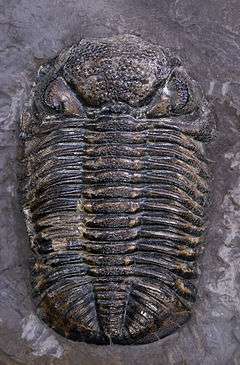Phacops rana
Phacops rana (Eldredgeops rana) is a species of trilobite from the middle Devonian period. Their fossils are found chiefly in the northeastern United States, southwestern Ontario, and in Morocco.
| Phacops rana Temporal range: Devonian | |
|---|---|
 | |
| Scientific classification | |
| Kingdom: | |
| Phylum: | |
| Class: | |
| Order: | |
| Family: | |
| Genus: | |
| Species: | P. rana |
| Binomial name | |
| Phacops rana (Green, 1832) | |
| subspecies | |
| |
Description

Phacops rana can be recognized by its large eyes (which remind some observers of a frog's eyes—the specific name rana is a reference to a common frog), its fairly large size (up to 6 inches long), and its habit of rolling up into a ball like a pill bug ("volvation"). In order to protect themselves from predators, Phacops rana would roll into a ball with its hard exoskeleton on the outside as protection. Many other trilobites possessed the same ability, but Phacops rana nearly perfected it. The slightest amount of sediment would trigger their senses, and Phacops rana would be hidden in a tiny shelter made of its own body. Although this safety feature often helped them to evade predators, occasionally it backfired and the trilobite would be buried under heavy sediment. Their fossils can still be found in balled-up positions 400 million years later.
Fossilisation
Phacops rana is found both in the northeastern U.S. and in Morocco; North America was attached to the African plate during the Devonian.
Because of its abundance and popularity with collectors, Phacops rana was designated the Pennsylvania state fossil by the state's General Assembly on December 5, 1988.[2]
Phacopid eyes

The most striking feature of the morphology of Phacops rana and its relatives is their eyes. These differed from the eyes of most trilobites in having comparatively few lenses spaced between deep sclera. The lenses themselves were very rounded instead of largely flat. The eyes were mounted on turret-like structures which could swivel, providing the animal with an almost 360-degree field of view. This type of eye is known as the schizochroal eye.
References
- Burton, C.J.; Eldredge, N. (1974). "Two new subspecies of Phacops rana (Trilobita) from the Middle Devonian of North-West Africa" (PDF). Palaeontology. 17 (2): 349. Archived from the original (PDF) on 2013-11-04.
- Harper, John (2013). "Reflections on Phacops rana (Green), Pennsylvania's State Fossil" (PDF). Pennsylvania Geology. 43 (2): 3–10.
- Some of the information in this article was taken from the website A Guide to the Orders of Trilobites, by Sam Gon III.
- Picture courtesy of "Valdosta State University Virtual Fossil Museum". Phacops Rana. Retrieved August 22, 2005.
- Color reconstruction of Eldredgeops (Phacops) rana at www.emilydamstra.com
